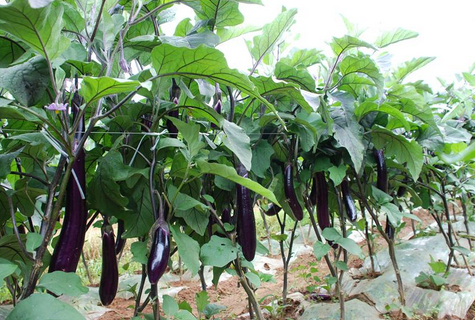(1) It is advisable to select suitable varieties for low-light and low-temperature, medium-potential, low-status, easy-to-fruit, and fruit-producing varieties. At present, the main varieties used in the southern region are Xiangzao, Xiangjia No. 1, Yuefeng Zihong, Chunchen Early Red, Royal Prince, and Suqi.
(2) Early-breeding seedlings should be seedling early in the middle and late October, and seedlings in the greenhouse seedling bed or nutrient mash in the middle and late November, and the seedlings survive before the low temperature. The ability of eggplant seedlings to withstand low temperature is weaker than that of pepper, and the wintering insulation measures should be strengthened. It is advisable to use three layers of covering.

(3) Strict soil disinfection, the key to re-application of base fertilizer eggplant cultivation is to prevent the occurrence of Verticillium wilt and ensure seedlings. A more successful experience is to pay attention to soil disinfection. Before the soil is plowed, the lime is 3,000 kg per hectare. Eggplant is resistant to fertilizer and requires high soil fertility. Therefore, it is necessary to reapply the base fertilizer. Apply 60,000 kilograms of organic fertilizer per hectare, 1500 to 2,250 kilograms of cake fertilizer, 1125 kilograms of compound fertilizer or 300 kilograms of urea, 750 kilograms of phosphate fertilizer, and 300 kilograms of potassium fertilizer. The application of the base fertilizer is preferably carried out in a full layer.
(4) Immediately after the application of the mulching film base fertilizer, the soil should be prepared. The width of the raft is 1 meter, the width of the trench is 0.5 meters, and the depth of the trench is 0.3 meters. Cover the mulch immediately after the soil preparation. The land preparation film should be completed 10 days before transplanting.
(5) Early planting, reasonable dense planting of spring eggplants in greenhouses, should be planted in sunny days from late February to early March. 2 rows per plant, plant spacing 35 cm, planting 34,500 plants per hectare. Immediately after planting, the solution of methyl thiophanate was poured as compressed water, and the wells were fixed with soil or fine soil.
(6) greenhouse management
1 temperature and humidity adjustment. In the early stage of growth, the main purpose of closed shed insulation is to promote seedling survival and early birth. When the temperature rises rapidly on a sunny day, the film should be released 2 hours before noon; the rainy days are closed. When the temperature is stable above 15 °C, it is necessary to strengthen the film to release the wind; no wind and no rain at night, can open the shed to promote seedling and steady growth. When the temperature is stable above 20 °C, it can be large, but the top film is not removed, it can still be used for rain protection, it can prevent continuous rain and rain, and the humidity in the field is large and the disease is prevalent.
2 pruning and threshing. After the eggplant enters the initial flowering stage, the buds on the base side sprout more, which not only consumes nutrients, but also affects ventilation and light transmission, and should be pruned in time. The whole branch should adopt cup-shaped pruning, that is, only one strong side branch is reserved under the first branch, and the other side branches are erased. After the side branches are preserved, the fruit is topped. This method can increase the early yield of eggplant. In the middle stage of eggplant growth, the function of the old leaves of the base is lost, and it becomes a useless leaf. It is an opportunity for the ventilation and light transmission in the crown, which results in more fruit, fruit, and fruit, which makes the fruit brighter and reduces the chance of infection of the old leaf. The old leaves should be destroyed in time.
3 hormones preserve fruit. In the early stage, the temperature of the eggplant in the greenhouse was low, and the fruit was often dropped due to low temperature. The fruit stalk was applied with 24-D of 30-40 mg/L, or sprayed with 30-40 mg/L.
4 timely harvest. The cultivation of eggplant in the greenhouse can be harvested and listed in the end of April. For the root cane, it should be picked early, and the eggplant and the four-door eggplant should be picked. It is harvested once every 2 to 3 days, which not only grabs the market price, but also promotes the subsequent development of the fruit to ensure continuous high yield.
5 pest control. The main diseases of eggplant are verticillium wilt and cotton blight. The control of Verticillium wilt is focused on rotation, strict soil disinfection, and heavy lime application. In recent years, the use of eggplant grafting and root replacement technology in Japan has been effective in controlling the disease. For the plague disease, it can be prevented by spraying at the beginning of the disease. The insect pests of eggplant mainly include aphids, cotton bollworms, 28-star ladybugs, and sassafras. The locusts are controlled by enemy cockroaches; the cotton bollworm and the 28-star ladybug are controlled by kungfu or card gram spray; the samovar is controlled by ketone and ketone.
Greenhouse Wet Pad For Cooling System
"Wet curtain - fan" of the vertical ventilation cooling combination is the most economical and effective measures to cool the greenhouse in summer.
Years from the application of a real show, even in the heat of the day reported, the rational design and installation of a fan of wet curtain cooling system can still control the greenhouse temperature at 30 °C, in order to heat the greenhouse to reduce the adverse effects minimum. In the summer, your production needs Jienuo wet curtain to help.
Greenhouse Wet Pad For Cooling System,Greenhouse Wet Curtain,Greenhouse Cooling Pad,Greenhouse Cooling Paper
JIANGSU SKYPLAN GREENHOUSE TECHNOLOGY CO.,LTD , https://www.thgreenhouse.com